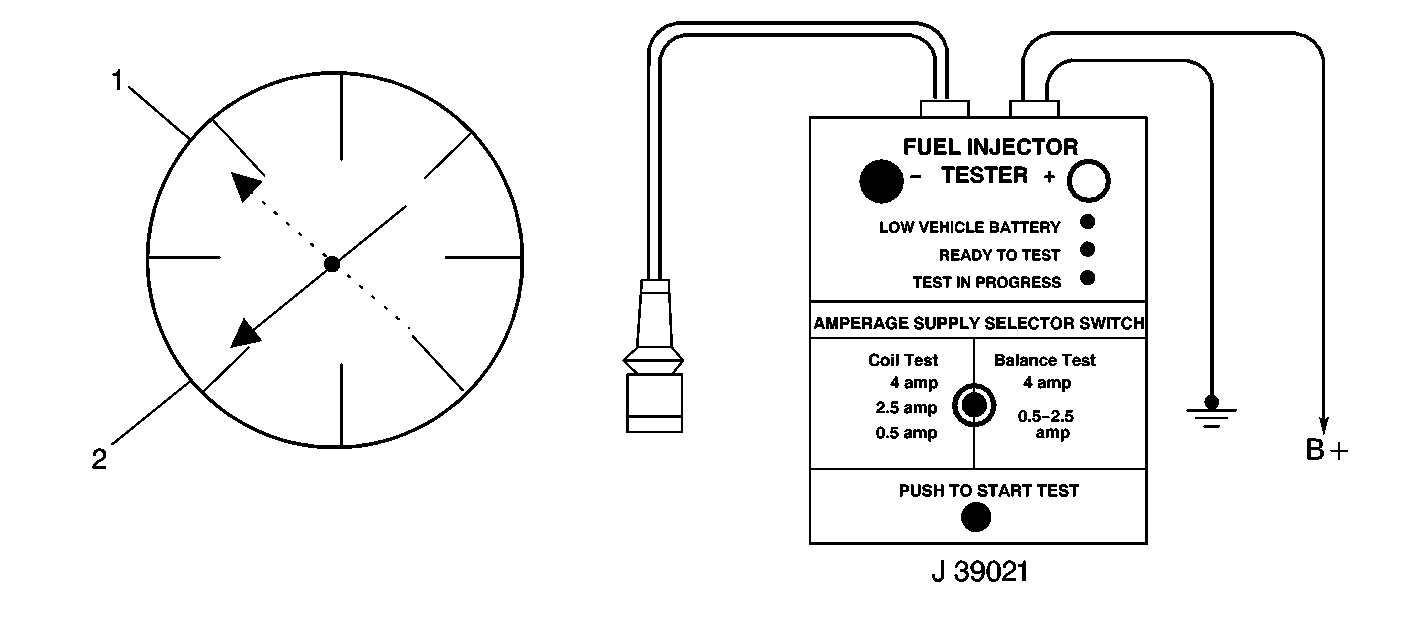The number below refers to the step number on the diagnostic table.
Step
| Action
| Values
| Yes
| No
|
Schematic Reference:
Engine Controls Schematics
Connector End View Reference:
Engine Controls Connector End Views
or
Powertrain Control Module Connector End Views
|
1
| Did you perform the Diagnostic System Check - Vehicle?
| --
| Go to
Step 2
| Go to
Diagnostic System Check - Vehicle
|
2
| Did you perform the Fuel Injector Coil Test?
| --
| Go to
Step 3
| Go to
Fuel Injector Solenoid Coil Test
|
3
|
Important : Do not perform this test if the engine coolant temperature (ECT) is above 94°C (201°F).
Observe the ECT Sensor parameter with a scan tool.
Is the ECT Sensor parameter less than the specified value?
| 94°C (201°F)
| Go to
Step 4
| --
|
4
|
Important: Verify there is adequate fuel in the fuel tank before proceeding with this diagnostic.
- Turn OFF the ignition.
- Install the fuel pressure gage. Refer to
Fuel Pressure Gage Installation and Removal
.
- Turn ON the ignition, with the engine OFF.
- Command the fuel pump ON with a scan tool.
Important:
| • | You may need to command the fuel pump ON a few times in order to obtain the highest possible fuel pressure. |
| • | Do not start the engine. |
- Observe the fuel pressure gage, with the fuel pump commanded ON.
Is the fuel pressure within the specified range?
| 385-425 kPa (55-62 psi)
| Go to
Step 5
| Go to
Fuel System Diagnosis
|
5
|
Important: The fuel pressure may vary slightly when the fuel pump stops operating. After the fuel pump stops operating, the fuel pressure should stabilize and remain constant.
Monitor the fuel pressure gage for 1 minute.
Does the fuel pressure drop more than the specified value?
| 34 kPa (5 psi)
| Go to
Fuel System Diagnosis
| Go to
Step 6
|
6
|
Notice: Do Not repeat any portion of this test before running the engine in
order to prevent the engine from flooding.
Important: Refer to the illustration in the supporting text when performing the following steps.
- Connect the
J 39021
Fuel Injector Coil and Balance Tester and the
J 39021-380
Fuel Injector Test Harness to a fuel injector.
- Set the amperage supply selector switch on the fuel injector tester to the Balance Test 0.5-2.5 amp position.
- Command the fuel pump ON and OFF with a scan tool.
- Record the fuel pressure indicated by the fuel pressure gage after the fuel pressure stabilizes. This is the first pressure reading.
Important: Record the fuel pressure value immediately after the fuel injector stops pulsing. The fuel pressure may rise after the fuel injector stops pulsing. Do not record the higher fuel pressure value.
- Energize the fuel injector by depressing the Push to Start Test button on the fuel injector tester.
- Record the fuel pressure indicated by the fuel pressure gage. This is the second fuel pressure reading.
- Repeat steps 1-6 for each fuel injector.
- Subtract the second pressure reading from the first pressure reading for one fuel injector. The result is the pressure drop value.
- Obtain a pressure drop value for each fuel injector.
- Add all of the individual pressure drop values. This is the total pressure drop.
- Divide the total pressure drop by the number of fuel injectors. This is the average pressure drop.
Does any fuel injector have a pressure drop value that is more than the average pressure drop or less than the average pressure drop by the specified value?
| 20 kPa (3 psi)
| Go to
Step 7
| Go to
Symptoms - Engine Controls
|
7
| Clean the fuel injectors. Refer to
Fuel Injector Cleaning
.
Did you complete the procedure?
| --
| Go to
Step 8
| --
|
8
| Operate the vehicle in order to verify the repair.
Does a driveability condition still exist?
| --
| Go to
Symptoms - Engine Controls
| System OK
|

